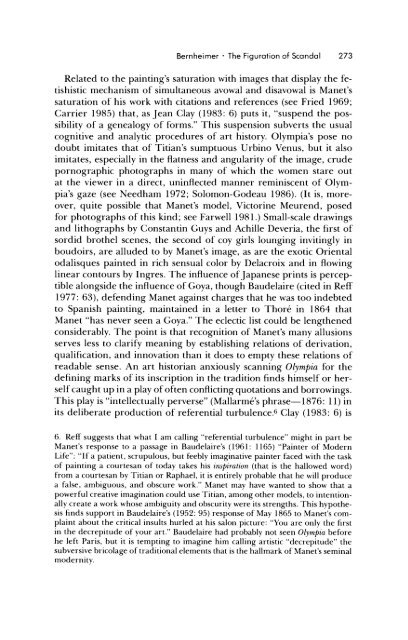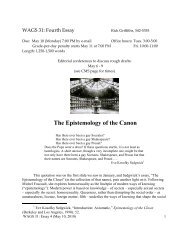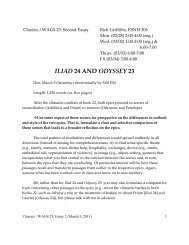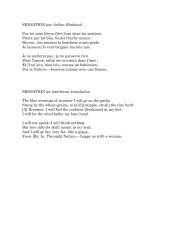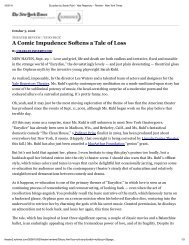Manet's Olympia: The Figuration of Scandal
Manet's Olympia: The Figuration of Scandal
Manet's Olympia: The Figuration of Scandal
Create successful ePaper yourself
Turn your PDF publications into a flip-book with our unique Google optimized e-Paper software.
Bernheimer * <strong>The</strong> <strong>Figuration</strong> <strong>of</strong> <strong>Scandal</strong> 273<br />
Related to the painting's saturation with images that display the fetishistic<br />
mechanism <strong>of</strong> simultaneous avowal and disavowal is <strong>Manet's</strong><br />
saturation <strong>of</strong> his work with citations and references (see Fried 1969;<br />
Carrier 1985) that, as Jean Clay (1983: 6) puts it, "suspend the possibility<br />
<strong>of</strong> a genealogy <strong>of</strong> forms." This suspension subverts the usual<br />
cognitive and analytic procedures <strong>of</strong> art history. <strong>Olympia</strong>'s pose no<br />
doubt imitates that <strong>of</strong> Titian's sumptuous Urbino Venus, but it also<br />
imitates, especially in the flatness and angularity <strong>of</strong> the image, crude<br />
pornographic photographs in many <strong>of</strong> which the women stare out<br />
at the viewer in a direct, uninflected manner reminiscent <strong>of</strong> <strong>Olympia</strong>'s<br />
gaze (see Needham 1972; Solomon-Godeau 1986). (It is, moreover,<br />
quite possible that <strong>Manet's</strong> model, Victorine Meurend, posed<br />
for photographs <strong>of</strong> this kind; see Farwell 1981.) Small-scale drawings<br />
and lithographs by Constantin Guys and Achille Deveria, the first <strong>of</strong><br />
sordid brothel scenes, the second <strong>of</strong> coy girls lounging invitingly in<br />
boudoirs, are alluded to by <strong>Manet's</strong> image, as are the exotic Oriental<br />
odalisques painted in rich sensual color by Delacroix and in flowing<br />
linear contours by Ingres. <strong>The</strong> influence <strong>of</strong> Japanese prints is perceptible<br />
alongside the influence <strong>of</strong> Goya, though Baudelaire (cited in Reff<br />
1977: 63), defending Manet against charges that he was too indebted<br />
to Spanish painting, maintained in a letter to Thore in 1864 that<br />
Manet "has never seen a Goya." <strong>The</strong> eclectic list could be lengthened<br />
considerably. <strong>The</strong> point is that recognition <strong>of</strong> <strong>Manet's</strong> many allusions<br />
serves less to clarify meaning by establishing relations <strong>of</strong> derivation,<br />
qualification, and innovation than it does to empty these relations <strong>of</strong><br />
readable sense. An art historian anxiously scanning <strong>Olympia</strong> for the<br />
defining marks <strong>of</strong> its inscription in the tradition finds himself or herself<br />
caught up in a play <strong>of</strong> <strong>of</strong>ten conflicting quotations and borrowings.<br />
This play is "intellectually perverse" (Mallarme's phrase-1876: 11) in<br />
its deliberate production <strong>of</strong> referential turbulence.6 Clay (1983: 6) is<br />
6. Reff suggests that what I am calling "referential turbulence" might in part be<br />
<strong>Manet's</strong> response to a passage in Baudelaire's (1961: 1165) "Painter <strong>of</strong> Modern<br />
Life": "If a patient, scrupulous, but feebly imaginative painter faced with the task<br />
<strong>of</strong> painting a courtesan <strong>of</strong> today takes his inspiration (that is the hallowed word)<br />
from a courtesan by Titian or Raphael, it is entirely probable that he will produce<br />
a false, ambiguous, and obscure work." Manet may have wanted to show that a<br />
powerful creative imagination could use Titian, among other models, to intentionally<br />
create a work whose ambiguity and obscurity were its strengths. This hypothesis<br />
finds support in Baudelaire's (1952: 95) response <strong>of</strong> May 1865 to <strong>Manet's</strong> complaint<br />
about the critical insults hurled at his salon picture: "You are only the first<br />
in the decrepitude <strong>of</strong> your art." Baudelaire had probably not seen <strong>Olympia</strong> before<br />
he left Paris, but it is tempting to imagine him calling artistic "decrepitude" the<br />
subversive bricolage <strong>of</strong> traditional elements that is the hallmark <strong>of</strong> <strong>Manet's</strong> seminal<br />
modernity.


